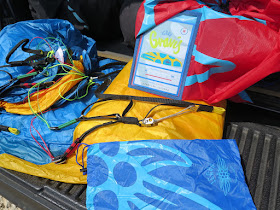NOVA Mentor 5
After test flying all the Mentor series from the first one till the 4th in S size, here’s the 5th edition in S size ready for a test flight at 95 all up.
I need to clarify a small but important fact, which most of you already know.
NOVA Mentor series were super efficient over the years, and with the Mentor 4 overall performance dominating the B category, and also competing with some of the higher classes, Nova has raised the bar very high. Being a reference in any category puts lots of pressure on any manufacturer, as doing better could be doable, but surely more difficult to achieve.
Launching the Mentor 5 is easier than the 4. It inflates rapidly and shows a smooth take off behavior.
 I wasn’t a fan of the elastic brake authority of the Mentor 3, and some pilots described the brake feel under the Mentor 4 as senseless in a way.
I wasn’t a fan of the elastic brake authority of the Mentor 3, and some pilots described the brake feel under the Mentor 4 as senseless in a way.
The handling and the way to turn the Mentor 5 is now enhanced a bit over the 3rd and 4th version.
The brake travel has an average pressure and travel. Slightly less than the Mentor 4 in pressure feel, with more agility in turns.
I could quickly confirm a better agility for the Mentor 5 in turns. But lets talk about precision feel in the brakes.
Perhaps some minority pilots including myself (the picky ones ;-) ) would have wanted that edge in brake feel. A more subtle feel, a character.
For example: I like my gliders to have a swift, precise, ‘linear feel’ thought the pull of each centimeter on the brakes. And if the brakes transmit the movements of the glider, then this would be the cherry on the cake! A glider that feels an extension to your arm.
If I can give a grade for the Mentor 3 precision feel I would put: 4/10 .The Mentor 4= 5/10 .The precision feel under the Mentor 5, is 6/10, which leaves the precision feel under the amazing Mentor 2 S at 8.0 /10 regardless of its high brake pressure.
I could give a loaded Phantom 7.0 /10
Bear in mind that the Mentor 5 S is more agile in inducing turns than the Mentor 4 and the Phantom S.
Climbing in very weak conditions is the Mentor 5 strong point. Every bubble encountered is converted smoothly and comfortably into heights. The nose isn’t as aggressive in biting forward as the Mentor 4 one. It’s smoother and more comfortable to fly in overall turbulence. The Mentor 5 goes more toward the Mentor 3 comfortable feel rather than the Mentor 4 one.
The Mentor 5 seems to absorb the bumps and thermals.
Doing some glide comparison at trim with the Mentor 4 showed a slight edge in moving air for the Mentor 5 at trim speed, and slightly on the top speed.
Gliding with a Chili 4 XS (Max 95) showed a similar glide for the Mentor 5 S (max 100) and i couldn’t give the edge to either one ! Both in climb and glide.
Surprisingly, the Mentor 5 gave me that extra comfort feel which wasn’t available before on the Mentor 4 !
The Mentor 5 pilot will have an edge in climbing over the pilot on the Mentor 4 if they both have the same skills and luck…
The top speed is similar to the Mentor 4 with a better float-ability in glides for the Mentor 5.
If anyone will fly the Mentor 5, he will experience a cool B glider, pleasurable easy handling, overall performance straight on top of the shelf, and very good comfort in turbulence for the high B category.
I would have appreciated to this excellent overall performance, that linear, precise, brake feel i was writing above, with more received information through the brakes. The Mentor 2 in S size was excellent in that matter! But harder on the brakes.
What’s the difference between the 4th and the 5th? (Best +++)
+ Glide efficiency
+++ Climb rate
+++ Ease of use
++ Handling
++ Overall feel and comfort
Ears are stable, efficient and reopen quickly on the S at 97 all up. Induced asymmetric are super easy to control. Holding the A riser down , i could easily turn the M5 to the other side by applying 15 cm of brake. Induced frontals recover very quickly. Wing overs need implication to built up, but quite homogenous.
Conclusion: The Mentor 5 is another NOVA success in the top B performers. I can resume it as a top gliding performance in a cool manner, Excellent climb rate, comfortable to fly, agile handling… That’s the Mentor 5 .
UPDATE : I flew the Mentor 5 XS at 88. More dynamic, nicer handling, but still this little spongy feel on the brakes... it's ok...but i like gliders that have a crispy, linear , nimble brake response. The M5 XS just turns when you pull and its agile. Most pilots just want that...
The climb rate is still very good..the glide also. It feels like as small energetic kid going round and around his parents ;-)
The XS is fast and the top speed is usable and easy.
Induced asymmetrics are slightly more dynamic than the M5 S size especially the frontals, but they are fine for a B pilot.
Cheers,
Ziad








